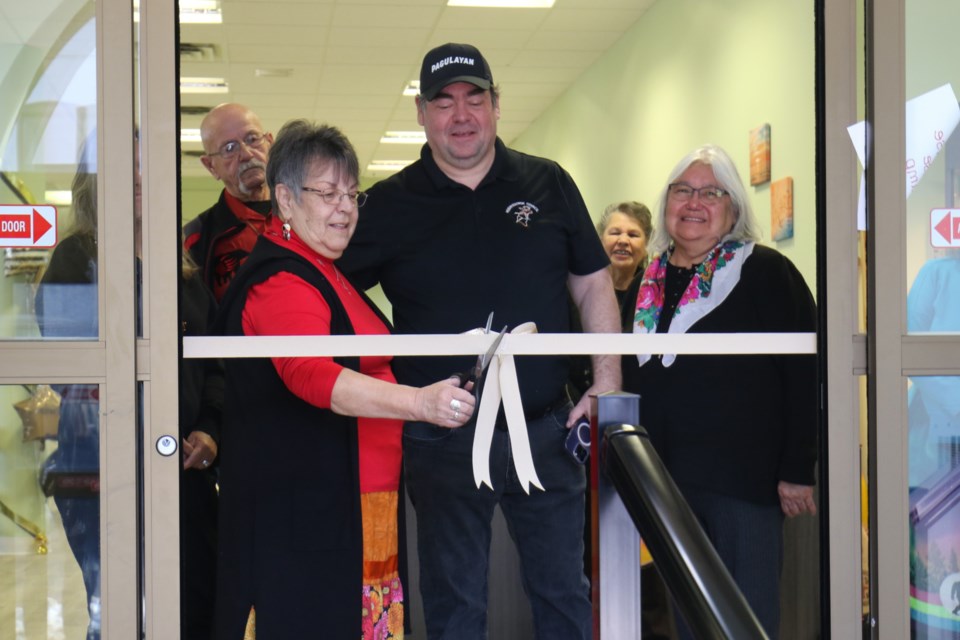Missanabie Cree First Nation celebrated the grand opening of its new band office — situated in the former Royal Bank of Canada building on Queen Street East — during a ribbon-cutting ceremony held there Wednesday.
The retrofitted building was purchased by the First Nation last year. Financial terms of the transaction have not been disclosed, but Missanabie Cree First Nation Chief Jason Gauthier told people in attendance for the ceremony that half of the building was paid for with the aid of unspecified grant money.
Deputy chief and council member Jutta Horn told SooToday that Missanabie Cree has come a long way from its humble beginnings in Sault Ste. Marie, when the then-landless First Nation began conducting its affairs from a small house on Bell’s Point in Garden River First Nation — with just five employees — back in 1995, with an annual budget of $35,000.
“But with the determination of our people and our vision, we worked very hard to get where we are today,” said Horn. “This is a testament to not only our growth, but our determination as a First Nation.”
There are currently no plans in the works for the community’s former band office at 559 Queen Street East. Two of Missanabie Cree’s ventures, ISN Maskwa and Missanabie Cree Business Corporation, continue to be housed next door to the former band office.
Staff members and councillors expressed excitement over the new digs, which they say will provide additional room for growth down the road.
“We were so happy when we did the transition to this space,” said family services supervisor Bonnie Wiebe, adding that the new offices allow the First Nation to host additional programming and activities for band members, particularly for elders and youth. “There’s going to be a lot more things happening, and we’re so excited about it.”
The band has come a long way since the early 1990s, when it began with three objectives: Identify and locate their members, find a space for them to gather and to launch a land claim in order to recover their homeland.
Three decades later, the once landless First Nation has completed those objectives, with more than 630 registered members, a band office and thousands hectares of land in its traditional territory, located approximately 100 kilometres northeast of Wawa, Ont.
Missanabie Cree First Nation successfully struck an agreement with Ontario for a land transfer of more than 3,800 hectares of Crown land near Missanabie, Ont. in 2011. Seven years later, the First Nation announced that a long-outstanding specific claim had been settled with Canada, resulting in the community gaining nearly 3,900 hectares of reserve land in its traditional territory, located approximately 100 kilometres northeast of Wawa, Ont.
The community was granted reserve status by the federal government in 2018 — after more than a century of being a landless community, despite a promise made by the Crown in 1906 to set aside reserve lands for each band under the terms of Treaty 9. Missanabie Cree people were dispersed throughout Ontario as a result, with members making homes in Sault Ste. Marie, Wawa, Thunder Bay, Toronto, Sudbury, and London.
In 2020, the First Nation settled a Treaty Land Entitlement claim with the Canadian government, providing approximately $150 million in financial compensation, with a portion flowing to band members through per capita distribution.
While the grand opening of its new band office was a cause for celebration Wednesday, the community’s deputy chief says it’s a stepping stone towards Missanabie Cree’s ultimate goal of relocating band members to its traditional territory.
“The intention has always been to bring our people home, to build our community and to build an economy for our people to be able to sustain a livelihood,” Horn said. “It was always the intention of building our band office when the people are there.”
Construction on a handful of new homes is slated to begin this spring. “This is our beginning — it’s part of those steps to make our way back home to the land of our ancestors,” Horn said.
